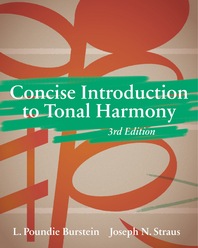
Concise Introduction to Tonal Harmony
Third Edition
1 July 2025
Territory Rights — Worldwide.
Description
A guidebook to the most important things your students need to know
Successfully used by thousands of students at hundreds of schools, Concise Introduction to Tonal Harmony represents a tested, concise approach to the tonal harmony textbook. The text introduces all the topics typically covered in the undergraduate theory sequence—fundamentals, diatonic and chromatic harmony, form, and post-tonal theory—but the focus is on carefully annotated notated musical examples rather than lengthy prose explanations of rules and exceptions, and engaging online tools help students build skills. This is a text your students will be able to read and comprehend, freeing up class time for enriching discussions and activities.
Burstein and Straus—both experienced classroom teachers—illustrate concepts using a repertoire of music from a diverse range of composers in the Western tradition. The Third Edition increases the diversity of the selections with new pieces by J. Rosamond Johnson, Eva Jessye, Tania Léon, and more historically marginalized composers. Additionally, you can more easily incorporate jazz and popular music into your course with new teaching resources and worksheets on jazz and popular music topics.
Digital Teaching and Learning Tools
Norton Illumine E-Book
The Norton Illumine Ebook enhances students’ reading and learning experience. Engaging features illustrate and reinforce core concepts for all students in a supportive, accessible, and low-stakes environment. You can embed your own content into the text and promote student accountability through easy-to-use assignment tools in your LMS.
Know It? Tutorials
In these low-stakes tutorials, short, animated videos break down important concepts in each chapter and illustrate key points, and short quizzes ensure students understand each concept.
Show It! InQuizitive Activities
InQuizitive is Norton’s easy-to-use adaptive learning tool that personalises the learning experience for students, helping them to learn—and retain—key learning objectives. Through a variety of question types—many including musical notation—answer-specific feedback, and gamelike elements such as the ability to adjust their confidence level for each question, students are motivated to keep working until they’ve learned the concepts.
Playlists
A collection of streaming audio recordings for all the examples discussed in the text and in the workbook.



